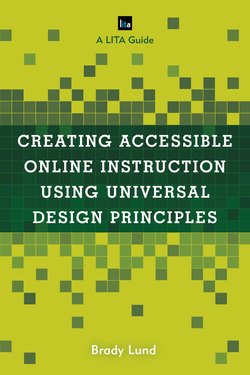Оглавление
Brady Lund. Creating Accessible Online Instruction Using Universal Design Principles
Preface
Accessibility
Accessibility
Brief History of Accessibility Legislation in the United States
What Is Section 508?
Related Legislation/Guidelines. Section 501
Section 504
Americans with Disabilities Act
2008 Amendments
Individuals with Disabilities Education Act
Technology-Related Assistance for Individuals with Disabilities Act (1988)/Assistive Technology Act (2004)
W3C WCAG
European Unified Approach for Accessible Lifelong Learning
Some Criticisms of Section 508 and Related Legislation/Guidelines
What’s Ahead?
Notes
Introducing Universal Design for Learning and Web Content Accessibility
Universal Design
Universal Design for Learning
Web Content Accessibility Guidelines
The WCAG and Criteria[10]
Additional 508 Final Rule Guidelines
What Does This All Mean?
What Does This Mean for Information and Communications Technology?
What Does This Mean for Educational Systems?
Notes
Developing Online Content with UDL
What Does UDL Mean for Online Learning?
Formatting of Assignment Instructions/PowerPoint Presentations
Interactive Elements
Quizzes
Asynchronous and Technology-Facilitated Communications
Designing Educational Experiences
Video Recording
Providing Choice for the Student
How Do We Present and Describe Information?
Hardware and Software
Accessible Hardware (Keyboard, Mouse, Headphones)
Screen Readers
Speech-to-Text
UDL Scan Tool
WAVE Tool
Learning Management Systems Features
Other Challenges and Opportunities with UDL. Open Educational Resources
Copyright
Reluctant Innovator
Outdated Systems and Cost
Handwritten Notes and Formulae
External Websites
Library Print Collections
Hostile Culture
Wrap Up
Notes
Content
Effective Communication in Person and Online
Importance of Communication in the Library and Information Professions
What Is “Effective Communication”?
Effective Asynchronous/Online Communication
Developing an Accessibility/Online. Communication Statement
Positive Behavioral Support: A Communication Model for Creating a. Culture of Inclusion
Final Words
Notes
Balancing Accessibility and Engagement
Being Creative with UDL. Augmented, Mixed, and Virtual Reality
Video Games
Interaction with Learning Artifacts
Modalities of Library Instruction
Artistic Expressions
Getting into the “Real World”
UDL and Flipped Learning
UDL and Instructional Processes: Some Cases
UDL and Student Performance and Persistence
Creatively Structuring an Accessible Classroom
Notes
Evolution
How Accessibility Evolves with New Innovation
Accessibility and Library Innovations
Exploring Accessibility in Historical Innovations
Email
Mobile Phones
Google Search
Summarizing the Major Takeaways
Notes
Case Studies
Wichita State University
Emporia State University
Pennsylvania State University
De Anza College
A Few Other Exemplars
Demonstrating the Need for Accessibility: A Case of the University of Texas
The Send Off
Notes
Glossary
Index
About the Author
Отрывок из книги
I imagine I wanted to be a published author and present at conferences ever since I was four years old, watching Men in Black and Pulp Fiction (you know, normal shows four-year-olds watch that make them want to become those things). Probably the biggest barrier to achieving that goal was my mental illnesses: social anxiety, generalized anxiety, panic, attention deficit. Though I struggled to speak in public (and was virtually mute outside home for several of my early years), I was for some reason always a good public speaker (I think because I never had to worry about being interrupted or proven wrong, at least until I was done speaking). I found writing was an amazing outlet to express my true personality (which is much lighter than my facial expressions and voice could convey).
I rarely mention my mental health struggles to anyone, but I want to do so here for two reasons. First, to assure readers who struggle with their own mental health problems that it is possible to overcome them and be successful in life. I am not the only person who will tell you this, but I am the only person whose book you are currently reading. My mental illnesses are extremely well controlled by this point in time (after years of struggling to “fix” things), and in the last three years, I have published nearly twenty peer-reviewed articles, many other edited articles in Library Journal and other publications, and three books, and I have presented at ALA, SLA, MLA, AECT, and LOEX conferences. I hope sharing this may give some comfort to readers who have similar experiences.
.....
Chapter 2 will introduce you to the principles of universal design for learning. This introduction will include some history (it is actually quite interesting how an architectural theory evolved into a theory of teaching and learning), but will focus largely on the principles themselves. On the surface, they can seem pretty vague, and that can easily turn people off. I want to be very clear about what each principle means, including examples of how this principle looks when applied in the “real world.”
In chapter 3, I want to narrow our focus to universal design for learning as it specifically applies to online learning and content. There are other books that describe universal design in the physical classroom, but it is my belief that—generally speaking—most universities, public institutions, and schools have a good idea of what they should be doing to make the physical classroom accessible, whether or not they actually do it. The challenge with online learning is that many instructors are not sure where to start; simply designing course content can be difficult for someone who has limited experience, let alone making it accessible. So, I want to tell you exactly where to start.
.....
